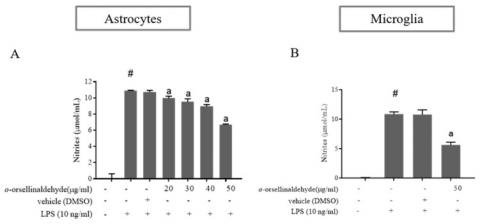Anti-Inflammatory and Immunomodulatory Effects of the Grifola frondosa Natural Compound o-Orsellinaldehyde on LPS-Challenged Murine Primary Glial Cells. Roles of NF-κβ and MAPK

Tomas-Hernandez S, Blanco J, Garcia-Vallvé S, Pujadas G, Ojeda-Montes MJ, Gimeno A, Arola L, Minghetti L, Beltrán-Debón R, Mulero M, In response to foreign or endogenous stimuli, both microglia and astrocytes adopt an activated phenotype that promotes the release of pro-inflammatory mediators. This inflammatory mechanism, known as neuroinflammation, is essential in the defense against foreign invasion and in normal tissue repair; nevertheless, when constantly activated, this process can become detrimental through the release of neurotoxic factors that amplify underlying disease. In consequence, this study presents the anti-inflammatory and immunomodulatory properties of o-orsellinaldehyde, a natural compound found by an in silico approach in the Grifola frondosa mushroom, in astrocytes and microglia cells. For this purpose, primary microglia and astrocytes were isolated from mice brain and cultured in vitro. Subsequently, cells were exposed to LPS in the absence or presence of increasing concentrations of this natural compound. Specifically, the results shown that o-orsellinaldehyde strongly inhibits the LPS-induced inflammatory response in astrocytes and microglia by decreasing nitrite formation and downregulating iNOS and HO-1 expression. Furthermore, in microglia cells o-orsellinaldehyde inhibits NF-κB activation; and potently counteracts LPS-mediated p38 kinase and JNK phosphorylation (MAPK). In this regard, o-orsellinaldehyde treatment also induces a significant cell immunomodulation by repolarizing microglia toward the M2 anti-inflammatory phenotype. Altogether, these results could partially explain the reported beneficial effects of G. frondosa extracts on inflammatory conditions.
Pharmaceutics,
2021, 13, 806
Pubmed: 34071571
Direct link: 10.3390/pharmaceutics13060806
